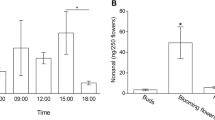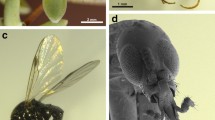Abstract
Visitation of orchids by Meliponini (stingless bees) is confirmed only in 13Melipona, Partamona andTrigona, forXylobium andMaxillaria, with the addition ofTrigona fulviventris visitingIonopsis. Some bees evinced multiple floral visitation by carrying several stipes and viscidia from pollinaria, thus may cause seed set. None foraged pseudopollen, nor is collection of this substance by bees verified. Meliponine-visited orchids had pollinia in quartets with emplacement on the bee's scutellum, possibly devices for pollinia survival on a social bee passing through its nest. Further, orchids produced no nectar, but bees repeatedly came to flowers. A testable basis for the orchid-meliponine relationship is mimicry of rewarding resources, or bee pheromone mimicry, recently documented for some honey bees. Meliponine pheromone analogs (nerol and 2-heptanol) are here noted forMaxillaria, but lack of foraging with pheromones byMelipona suggests multiple avenues of mimicry by orchids, including alarm pheromone and carrion mimicry.
Similar content being viewed by others
References
Ackerman J. D. (1983) Specificity and mutual dependency of the orchid-euglossine bee interaction. Biol. J. Linnean Soc. 20: 301–314.
Ackerman J. D. (1986) Mechanisms and evolution of food-deceptive pollination systems in orchids. Lindleyana 1: 108–113.
Dodson C. D. (1962) The importance of pollination in the evolution of the orchids of tropical America. American Orch. So. Bull. 31: 525–534, 641–649, 731–735.
Dodson C. D. (1965) Agentes de polinización y su influencia sobre la evolución en la familia Orquidaceae. Univ. Nac. Amazonia Peruana.
Dodson C. D., Frymire G. P. (1961a) Preliminary studies in the genusStanhopea. Ann. Missouri Bot. Gard. 48: 137–172.
Dodson C. D., Frymire G. P. (1961b) Natural pollination of orchids. Missouri Bot. Gard. Bull. 49: 133–139.
Dressler R. L. (1993) Field guide to the orchids of Costa Rica and Panama. Comstock Publishing Associates, Ithaca, New York.
Dressler R. L., Ospina-Torres R. (1997) Una nueva especie deEulaema (Hymenoptera: Apidae) del Choco, Colombia. Caldasia 119: 95–100.
Ducke A. (1902) Beobachtungen ber blutenbesuch, erscheiungszeit etc. der Bienen bei Para vorkommenden. A. Zeit. f. Ent. 7: 321–325, 360–368, 400–404, 417–421.
Eltz T., Whitten W. M., Roubik D. W., Linsenmair K. E. (1999) Fragrance collection, storage, and accumulation by individual male orchid bees. Journal of Chemical Ecology 25: 157–176.
Kaiser R. (1993) The scent of orchids. Olfactory and chemical investigations. Editiones Roche, Basel, Switzerland.
Kerr W. E., Lopez C. R. (1963) Biologia da reprodufão deTrigona (Plebeia) droryana F. Smith. Rev. Brasil. Biol. 22: 335–341.
Koulianos S. R., Schmid-Hempel R., Roubik D. W., Schmid-Hempel P. (1999) Phylogenetic relationships within the corbiculate Apinae (Hymenoptera) and the evolution of eusociality. Journal of Evolutionary Biology 12: 380–384.
Nieh J. C., Roubik D. W. (1998) Potential mechamisms for the communication of height and distance by a stingless bee,Melipona panamica. Behavioral Ecology and Sociobiology 43: 387–399.
Ospina Torres R., Sandino-Franco J. C. (1997)Eulaema chocoana, nueva especie de abeja euglosina de la costa pacífica colombiana. Caldasia 19: 165–174.
Pijl L. van der, Dodson C. H. (1966) Orchid flowers; their pollination and evolution. Univ. Miami Press, Coral Gables, Florida.
Pintaudi C. T., Stort M. N. S., Marin-Morales M. A. (1990) Artificial and natural pollination ofXylobium squalens Lindl. (Orchidaceae). Naturalia 15: 67–80.
Rodriguez C. R. L., Mora D. E., Barahona M. E., Williams N. H. (1986) Géneros de orquídeas de Costa Rica. Editorial Universidad de Costa Rica.
Roubik D. W. (1989) Ecology and natural history of tropical bees. Cambridge Univ. Press, New York.
Roubik D. W. (1996) Wild bees of Brunei-Darussalam. In: Edwards D., Choy S. (eds.) Tropcial rainforest research: current issues. Kluwer, The Netherlands, pp. 167–178.
Roubik D. W. (1999) Grave-robbing by maleEulaema (Hymenoptera, Apidae): implications for euglossine biology. Journal of the Kansas Entomological Society 71: 188–191.
Roubik D. W., Moreno J. E. (1991) Pollen and Spores of Barro Colorado Island. Monographs in Systematic Botany. No. 36. Missouri Botanical Garden, St. Louis, Missouri.
Sasaki M. (1992) Deception of Japanese honey beeApis cerana japonica by oriental orchid,Cymbidium pumilum. Honeybee Science 13: 167–172.
Sakagawa H., Mutsuyama S. (1999) Plant and insect co-evolution: the interaction between the oriental orchid (Cymbidium floribundum Lindl.) and the Japanese honeybee. In: Schwarz M. P., Hagendoorn K. (eds.) Social insects at the turn of the millennium: Proceedings of the XIII International Congress of the International Union for the study of social insects. Adelaide, Australia, p. 416.
Author information
Authors and Affiliations
Rights and permissions
About this article
Cite this article
Roubik, D.W. Deceptive orchids with Meliponini as pollinators. Pl Syst Evol 222, 271–279 (2000). https://doi.org/10.1007/BF00984106
Received:
Accepted:
Issue Date:
DOI: https://doi.org/10.1007/BF00984106




